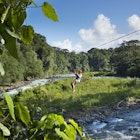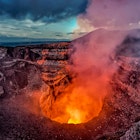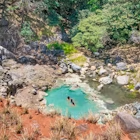
Wildlife watching away from the crowds on Costa Rica’s Osa Peninsula
Sponsored by
Aug 29, 2022 • 4 min read

If you take a walk on the wild side at Corcovado National Park, you’ll encounter far more animals than humans – including elusive Squirrel Monkeys © Photo by Jenn Parker / Lonely Planet; Graphics by Jacob Rhoades / Lonely Planet
The start of a great adventure often begins where the road ends. What’s unique about Costa Rica’s Osa Peninsula is that the road to the end runs parallel to unimaginable wild wonders.
Iridescent blue morpho butterflies weave through the thick undergrowth, gregarious scarlet macaws chitchat in the electric green canopy, and thousands of eyes peer at you without you noticing. Jaguarundis, anteaters, agoutis, and lizards that walk on water call this place home.
Life abounds on top of life along the rainforest-lined road. In fact, 2.5 percent of the planet’s biodiversity lives here – inside and around Costa Rica’s treasured Corcovado National Park. For natural explorers, it’s the perfect alternative to more bustling regions of the country like Arenal, and Manuel Antonio National Park in the summer.

World-class wildlife watching
Corcovado is home to a staggering 370 species of bird, 140 species of mammals and thousands of insect species, with more still waiting to be discovered. It’s one of the few national parks in Costa Rica with all four of the country’s primate species. Spider monkeys, mantled howlers (the second loudest animal in the world) and white-faced capuchins can be encountered anywhere, while the La Leone–Sirena trail is best for the fourth and most endangered species, the Central American squirrel monkey.
If you take a walk on the wild side here, you’ll encounter far more animals than humans. The park's demanding, multiday hiking trails attract devoted visitors who set out from Bahía Drake and Puerto Jiménez to see the wildlife and experience a bona fide jungle adventure. Trails are primitive and the hiking is hot and humid, but the challenge of the trek and the interaction with wildlife are thrilling.

No two hikes in the Corcovado National Park will ever be the same. However, it’s not uncommon to see the primates, as well as tamanduas (a small anteater with a 16-inch tongue), scarlet macaws (the healthiest population in Central America is found here) or a drift of dozens of white-lipped peccaries (they look like little pigs).
If you’re especially lucky, you might encounter one of the six wild cats that sometimes lurk around the trail but are rarely seen (jaguars, pumas, ocelots, oncillas, margays and jaguarundis), or the endangered giant Baird’s tapir (which can weigh as much as a lion).

Puerto Jiménez: gateway to the park
The quaint, colorful and somewhat frontier-feeling town of Puerto Jiménez is a great jumping-off-point, with everything you need to enjoy an adventure-packed stay on the Osa Peninsula. It’s a little more than 25 miles (40km) from La Leona ranger station and the Corcovado National Park entrance – buses take about three hours and cost about $10 USD (7000 CRC). Alternatively, direct flights and boat rides can take you to the famed Sirena Ranger Station.
Either way, Puerto Jiménez is the last town you’ll hit before the wilderness. It’s also where you can find tour operators like OSA Wild and the Corcovado National Park office. Since 2014, it has been mandatory to have an ICT (Costa Rican Institute of Tourism) accredited guide with you to enter the park. Your guide will not only ensure that you don’t get lost, but also that you see the most wildlife and learn about the park’s natural history.

A pre-purchased park permit is also required (you cannot purchase a permit at the entrance like other parks in Costa Rica). You can procure these for $15 through the national park office or your tour operator.
While in town, you can pick up hiking supplies, sample tasty local fare, and book other adventures like dolphin and whale watching. Check out a kayaking tour through a mangrove forest during the day or at sunset, when you can admire bioluminescent wildlife from your boat. South of Jiménez, the surfer haven of Cabo Matapalo and the jungle lodges of Carate beckon travelers in search of nature and solitude.

What to expect and what to bring
Hiking into the Corcovado National Park via La Leona is no “walk in the park.” This guided hike covers roughly 20 kilometers and typically takes seven to nine hours to complete. If you are prepared for such an enduring trek, though, it will likely be one of the best walks of your life.
Being prepared means bringing enough water (at least two to three liters in reusable bottles), wearing comfortable hiking shoes (waterproof ones are preferable), dressing in breathable, quick dry clothing, packing a good lunch and snacks, and applying (and reapplying) sunscreen and insect repellent. Packing a hat, sunglasses, binoculars, a camera and a swimsuit is also well advised.

Summertime is the rainy season, so a rain jacket and dry bag are musts. But don’t worry – a little rain won’t put a damper on your hike. It’s just part of the experience. The canopy is so thick on many parts of the trail that it will act like a natural umbrella with just a few holes. The steady rain adds a stroke of sparkle to the landscape in the form of every shade of green imaginable. Rainfall is refreshing for plants, animals and visitors alike; otherwise, the heat can get intense.
A walk in the wild woods of Corcovado is a rare opportunity to experience nature in all its blissful glory without the interference of overwhelming crowds. It’s the perfect opportunity to disconnect and reconnect in Costa Rica this summer.
Sponsored by Visa
As a travel entertainment and inspirational media outlet, we sometimes incorporate brand sponsors into our efforts. This activity is clearly labeled across our platforms.
This story was crafted collaboratively between Visa and Lonely Planet. Both parties provided research and curated content to produce this story. We disclose when information isn’t ours.
With sponsored content, both Lonely Planet and our brand partners have specific responsibilities:
Brand partner
Determines the concept, provides briefing, research material, and may provide feedback.
Lonely Planet
We provide expertise, firsthand insights, and verify with third-party sources when needed.
Explore related stories





 BeachesCosta Rica vs Panama: which of these Central American gems is right for you?
BeachesCosta Rica vs Panama: which of these Central American gems is right for you?Jun 4, 2024 • 7 min read
 National ParksThe 10 best national parks in Central America offer sea turtles, Mayan pyramids and volcanoes
National ParksThe 10 best national parks in Central America offer sea turtles, Mayan pyramids and volcanoesApr 20, 2022 • 6 min read
 Wildlife & NatureOsa Peninsula: a guide to the most adventurous corner of Costa Rica
Wildlife & NatureOsa Peninsula: a guide to the most adventurous corner of Costa RicaJun 28, 2021 • 6 min read
 SportsSurfing, hiking, diving, kayaking and more: Costa Rica's best adventure activities
SportsSurfing, hiking, diving, kayaking and more: Costa Rica's best adventure activitiesJan 29, 2020 • 7 min read

